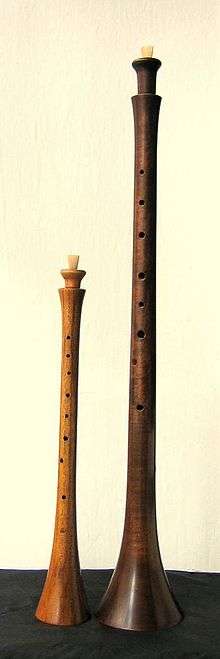Alta cappella

An alta cappella or alta musica (Italian), alta musique (French) or just alta was a kind of town wind band found throughout continental Europe from the thirteenth to the eighteenth centuries, which typically consisted of shawms and slide trumpets or sackbuts. Waits were the British equivalent. These were not found anywhere outside of Europe.[1][2]
History

Alta musique in general refers to the "loud music" of instruments like shawms, sackbuts, trumpets, and drums, in contrast to basse musique, the "soft music" of recorders, viols, fiddles, harps, psalteries, and the like.[3] These ensembles first appeared in Europe in the thirteenth century, taken from the ceremonial loud bands of the Arab World, consisting of small shawms, nakers, and other percussion, together with pairs of straight trumpets functioning as something of a cross between drone and percussion. In Europe, these instruments were sometimes augmented by bagpipes and pipe and tabor.[4] By the fifteenth century, these bands had come mainly to consist of three musicians, two playing shawms and the other a slide trumpet or (later) sackbut, but in the sixteenth century the size gradually increased and the instrumentation became more varied.[3] After about 1500 in Germany, the alta developed into the kind of band that came to be known as Stadtpfeifer (town pipers).[5] Present-day descendants of this tradition are the Catalan cobla bands who play dances called sardanas. The cobla features a modern version of the shawm with the main melody played by the tenor member of the family.[3]
Repertoire

There is one surviving composition from the late-fifteenth or early sixteenth century actually titled Alta. It is an untexted piece for three (presumably instrumental) voices by F[rancisco?] de la Torre, in the Spanish manuscript Cancionero de Palacio (E-Mp 2–1–5), and is assumed to be a typical example of the improvisatory style of this ensemble. It sets the popular basse danse tenor La Spagna in long notes with a contratenor in more or less note-against-note motion and a highly decorated fast-moving upper part.[3] Similar cantus-firmus settings from this period, mostly in three parts and in improvisatory style, may also be associated with these bands. Examples include pieces found in MS Trent 87,5 such as Auxce bon youre, Tandernaken, and the setting of the basse danse melody, Je suy povere de leesse.[6] During the sixteenth century, cantus firmus settings gave way to other kind of dances, sometimes improvised and sometimes composed. Music in four parts had become a normal texture by the early sixteenth century, and the bands accordingly increased in size.[3]
References
- ↑ Iain Fenlon, Music and Patronage in Sixteenth-Century Mantua, 2 vols., Cambridge Studies in Music (Cambridge and New York: Cambridge University Press, 1980–82)::2008, ISBN 978-0-521-229050 (vol 1); ISBN 978-0-521-23587-7 (vol. 2) "It is not until a few years later, in 1468, that the names of the Mantuan court alta cappella, a group of four players, are recorded. From its origins as a simple band used on ceremonial occasions, this ensemble seems to have been transformed .."
- ↑ Roy C. Strong-Feast: A History of Grand Eating 2002 - Page 123 "In the hall it was haute musique, itself divided between musica alta for wind bands and basse musique for soft instruments accompanied by voices."
- 1 2 3 4 5 Howard Mayer Brown, and Keith Polk, "Alta (i)", Grove Music Online, edited by Deane Root (accessed 28 January 2015)
- ↑ Herbert W. Myers, "Slide Trumpet Madness: Fact or Fiction?", Early Music 17, no. 3 (August 1989): 382–89. Citation on 383.
- ↑ Margaret Sarkissian and Edward H. Tarr, "Trumpet", Grove Music Online, edited by Deane Root (accessed 28 January 2015).
- ↑ Ross W. Duffin, "The Trompette des Ménestrels in the 15th-Century Alta Capella", Early Music 17, no. 3 (August 1989): 397–402. Citation on 399.
Further reading
- Brown, Howard Mayer, and Keith Polk. 2001. "Instrumental Music, c.1300–c.1520", in Music as Concept and Practice in the Late Middle Ages: Players, Patrons and Performance Practice, edited by Reinhard Strohm and Bonnie J. Blackburn, 97–162. The New Oxford History of Music, vol. 3, part 1. Oxford and New York: Oxford University Press. ISBN 978-0-19-816205-6.
- Downey, Peter. 1984. "The Renaissance Slide Trumpet: Fact or Fiction?" Early Music 12, no. 1 (February): 26–33.
- Heartz, Daniel. 1966. "Hoftanz and Basse Dance". Journal of the American Musicological Society 19, no. 1 (Spring): 13–36.
- Peters, Gretchen. 2001. "Civic Subsidy and Musicians in Southern France During the Fourteenth and Fifteenth Centuries: A Comparison of Montpellier, Toulouse and Avignon", in Music and Musicians in Renaissance Cities and Towns, edited by Fiona Kisby, 57–69. Cambridge and New York: Cambridge University Press. ISBN 978-0-521-66171-3.
- Polk, Keith. 1987. "Instrumental Music in the Urban Centres of Renaissance Germany". Early Music History 7:159–86.
- Polk, Keith. 1989. "The Trombone, the Slide Trumpet and the Ensemble Tradition of the Early Renaissance". Early Music 17, no. 3 (August): 389–97.
- Polk, Keith. 1992. German Instrumental Music of the Late Middle Ages. Cambridge and New York: Cambridge University Press.
- Polk, Keith, 2012. “Instrumental Performance in the Renaissance”. In The Cambridge History of Musical Performance, edited by Colin Lawson and Robin Stowell, 335–52. Cambridge and New York: Cambridge University Press. ISBN 978-0-521-89611-5.
- Tröster, Patrick. 2001. Das Alta-Ensemble und seine Instrumente von der Spätgotik bis zur Hochrenaissance (1300–1550). Eine musikikonografische Studie. Tübingen: Medien Verlag Köhler. ISBN 3-932694-77-5.
- Tröster, Patrick. 2004. "More about Renaissance Slide Trumpets: Fact or Fiction?" Early Music 32, no. 2 (May): 252–68.
External links
|